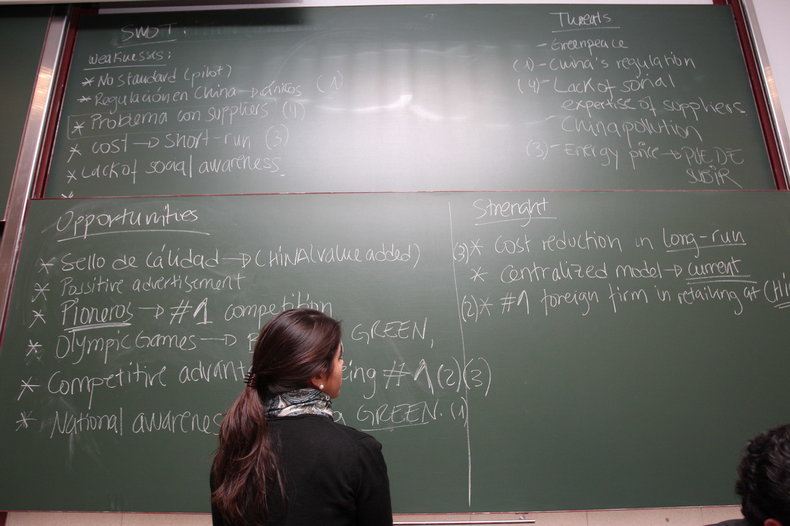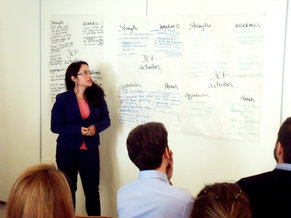
Strengths
SWOT strengths are competitive advantages whereby you do something better than most or all of the competition.Ability to scale | Able to comply with regulations |
Business capabilities - e.g. a restaurant that bakes its own bread | Creative company culture |
Cultural capital - able to influence customers / partners | Customer advocacy - customer feedback quickly incorporated into products |
Customer relationships | Economies of scale |
Efficient technologies | Efficient business processes |
Engaged employees | Financial resources |
Flexible & adaptable | Good business - environmental and social responsibility |
High work quality | Highly effective marketing |
Industry experience | Intellectual property |
Know-how | Lead the industry - others try to follow our strategy |
Location | Low cost for logistics such as delivery |
Low cost supply of inputs | Low costs of production |
Low risk exposure | Low time-to-market |
Low unit cost | Loyal customers |
Online presence | Partnerships |
Positive customer perceptions of brand / product | Product / service features |
Product / service performance | Product experience |
Productive employees | Quality of products |
Relational capital - value of your relationships | Reliable products |
Reputation | Responsive / fast turnaround time |
Sales & marketing effectiveness | Service quality |
Strength of brands | Strong leadership |
Successful projects - ability to change rapidly | Superior customer service |
Talent | Technology capabilities / know-how |
Unique / valuable business model | Unique brand / product positioning |
Unique knowledge | Unique product design |
Weaknesses
SWOT weaknesses are competitive disadvantages whereby the competition may be stronger than you in some area.Access to customers | Access to data |
Ad hoc processes / reactive mode | Bad publicity |
Brand disadvantage | Corporate narcissism |
Cost disadvantage | Customer dissatisfaction |
Dependent on a few employees | Difficult, slow and expensive to scale |
Difficulty closing sales | Difficulty generating leads |
Failed projects | Few customers |
Few products | Fragile processes - often break down |
High turnover | High unit cost |
Highly dependent on a partner | Ineffective value proposition |
Internal politics | Know-how / knowledge shortfall |
Lack of automation | Lack of financial resources |
Lack of internal cooperation | Lack of market access |
Lack of productivity tools | Low barriers to entry - easy to enter market |
Low brand recognition / awareness | Low employee engagement |
Low employee satisfaction | Low market share |
Low partner performance | Low product variety |
Poor customer service | Poor direction / inconsistent strategy |
Poor usability of internal tools and technologies | Poor usability of products and services |
Poor value proposition | Poor work quality |
Red tape | Resistance to change |
Revenue concentration - e.g. in one product category | Slow processes |
Stuck following the competition | Unreliable employees / partners |
Unstable technology | Weak customer relationships |
Weak distribution network | Weak online / social media presence |
Opportunities
SWOT opportunities are positive external conditions such as high demand for a product. The common mistake here is to list things you could do as opportunities when really this isn't a call for a plan but rather a list of favorable external conditions.Availability of talent | Changes to customer needs |
Changes to customer perceptions | Changing consumer preferences |
Competitors exit your market | Competitors experience reputational damage |
Competitors in decline | Consumer trends such as changing style preferences |
Demand changes such as demand for brands that have a positive impact on the world | Economic growth |
Economic stability | Emergence of new business models |
Emergence of new marketing techniques | Emergence of new markets & industries |
Existing brand recognition in your markets | Favorable demographic change |
Favorable economic conditions | Favorable government policies |
Government incentives or assistance | High / rising demand for a product or service |
Ideas from customers | Industry consolidation such as a large firm that buys smaller competitors |
Low labor costs | Low prices for inputs |
Low red tape | Loyal customers waiting for your next product |
Media interest in your products and brand | More efficient technologies, methods or approaches |
New competitors that lack capabilties | New technologies |
New ways to scale such as cloud computing or manufacturing outsourcing | Partnership opportunities |
Political stability | Reduced regulations |
Reduced trade barriers |
Threats
SWOT threats are external factors beyond your control that could have a negative impact on your business.Changes in customer needs and preferences | Competitors improve products and services |
Competitors with a lower cost base | Compliance issues |
Costs increase | Cybersecurity threats |
Declining partner performance | Decreased demand for products |
Disruption of business models | Exchange rate volatility |
Global competition | Inability to finance / refinance business |
Inflation | Legal disputes |
Loss of customers | Loss of key employees |
Loss of partners | Market prices fall |
Market saturation - reach a limit to growth in a market | Natural disasters, Labor shortages, Labor strikes, Bad publicity |
New competitors | New regulations |
Operational outages | Political disruptions |
Price competition | Price wars |
Quality of competing products | Recessions |
Regulatory actions | Supply chain disruptions |
Technological change | Technology outages |
The competitive actions of larger competitors |











































